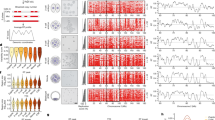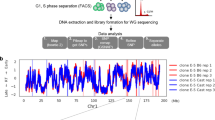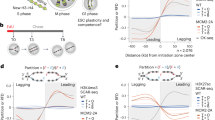Abstract
Genomic imprinting is characterized by allele-specific expression of multiple genes within large chromosomal domains1 that undergo DNA replication asynchronously during S phase2,3. Here we show, using both fluorescence in situ hybridization analysis and S-phase fractionation techniques, that differential replication timing is associated with imprinted genes in a variety of cell types, and is already present in the pre-implantation embryo soon after fertilization. This pattern is erased before meiosis in the germ line, and parent-specific replication timing is then reset in late gametogenesis in both the male and female. Thus, asynchronous replication timing is established in the gametes and maintained throughout development, indicating that it may function as a primary epigenetic marker for distinguishing between the parental alleles.
This is a preview of subscription content, access via your institution
Access options
Subscribe to this journal
Receive 51 print issues and online access
$199.00 per year
only $3.90 per issue
Buy this article
- Purchase on Springer Link
- Instant access to full article PDF
Prices may be subject to local taxes which are calculated during checkout




Similar content being viewed by others
References
Razin,A. & Cedar,H. DNA methylation and genomic imprinting. Cell 77, 473–476 (1994).
Kitsberg,D. et al. Allele-specific replication timing of imprinted gene regions. Nature 364, 459–463 (1993).
Knoll,J. H. M., Cheng,S.-D. & Lalande,M. Allele specificity of DNA replication timing in the Angelman/Prader-Willi syndrome imprinted chromosomal region. Nature Genet. 6, 41–46 (1994).
Selig,S., Okumura,K., Ward,D. C. & Cedar,H. Delineation of DNA replication time zones by fluorescence in situ hybridization. EMBO J. 11, 1217–1225 (1992).
Chess,A., Simon,I., Cedar,H. & Axel,R. Allelic inactivation regulates olfactory receptor gene expression. Cell 78, 823–834 (1994).
LaSalle,J. M. & Lalande,M. Domain organization of allele-specific replication within the GABRB3 gene cluster requires a biparental 15q11-13 contribution. Nature Genet. 9, 386–394 (1995).
Greally,J. M. et al. The mouse H19 locus mediates a transition between imprinted and non-imprinted DNA replication patterns. Hum. Mol. Genet. 7, 91–95 (1998).
Tenzen,T. et al. Precise switching of DNA replication timing in the GC content transition area in the human major histocompatibility complex. Mol. Cell. Biol. 17, 4043–4050 (1997).
Hansen,R. S., Canfield,T. KI., Lamb,M. M., Gartler,S. M. & Laird,C. D. Association of fragile X syndrome with delayed replication of the FMR1 gene. Cell 73, 1403–1409 (1993).
Kawame,H., Gartler,S. M. & Hansen,R. S. Allele-specific replication timing in imprinted domains: absence of asynchrony at several loci. Hum. Mol. Genet. 4, 2287–2293 (1995).
Windham,L. Q. & Jones,P. A. Expression of H19 does not influence the timing of replication of the Igf2/H19 imprinted region. Dev. Genet. 20, 29–35 (1997).
Wines,M. E., Tiffany,A. M. & Holdener,B. C. Physical localization of the mouse aryl hydrocarbon receptor nuclear translocator-2 (Arnt2) gene within the c112K deletion. Genomics 51, 223–232 (1998).
McCarrey,J. R. in Cellular and Molecular Biology of the Testis 58–89 (Oxford Univ. Press, Oxford, 1993).
Bix,M. & Locksley,R. M. Independent and epigenetic regulation of the interleukin-4 alleles in CD4+ T Cells. Science 281, 1352–1354 (1998).
Riviere,I., Sunshine,M. J. & Littman,D. R. Regulation of IL-4 expression by activation of individual alleles. Immunity 9, 217–228 (1998).
Gabriel,J. M. et al. A model system to study genomic imprinting of human genes. Proc. Natl Acad. Sci. USA 95, 14857–14862 (1998).
Shemer,R. & Razin,A. in Epigenetic Mechanisms of Gene Regulation (eds Russo, V. E. A., Martienssen, R. A. & Riggs, A. D.) 215–229 (Cold Spring Harbor Laboratory Press, Cold Spring Harbor, 1996).
Shemer,R. et al. Dynamic methylation adjustment and counting as part of imprinting mechanisms. Proc. Natl Acad. Sci. USA 93, 6371–6376 (1996).
Birger,Y., Shemer,R., Perk,J. & Razin,A. The imprinting box of the mouse Igf2r gene. Nature 397, 84–88 (1999).
Szabo,P. & Mann,J. R. Biallelic expression of imprinted genes in the mouse germ line: implications for erasure, establishment and mechanisms of genomic imprinting. Genes Dev. 9, 1857–1868 (1995).
Davis,T. L., Trasler,J. M., Moss,S. B., Yang, Bartolomei, M. S. Acquisition of the H19 methylation imprint occurs differentially on the parental alleles during spermatogenesis. Genomics 58, 18–28 (1999).
Caspary,T., Cleary,M. A., Baker,C. C., Guan,X.-J. & Tilghman,S. M. Multiple mechanisms regulate imprinting of the mouse distal chromosome 7 gene cluster. Mol. Cell. Biol. 18, 3466–3474 (1998).
Sutcliffe,J. S. et al. Deletions of a differentially methylated CpG island at the SNRPN gene define a putative imprinting control region. Nature Genet. 8, 52–58 (1994).
Leighton,P. A., Ingram,R. S., Eggenschwiler,J., Efstratiadis,A. & Tilghman,S. M. Disruption of imprinting caused by deletion of the H19 gene region in mice. Nature 375, 34–39 (1995).
Gunaratne,P. H., Nakao,M., Ledbetter,D. H., Sutcliffe,J. S. & Chinault,A. C. Tissue-specific and allele-specific replication timing control in the imprinted human Prader-Willi syndrome region. Genes Dev. 9, 808–920 (1995).
Hogan,B., Beddington,R., Costantini,F. & Lacy,E. Manipulating the Mouse Embryo. A Laboratory Manual (Cold Spring Harbor Laboratory, Cold Spring Harbor, 1994).
McCarrey,J. R., Hsu,K. C., Eddy,E. M., Klevecz,R. R. & Bolen,J. L. Isolation of viable mouse primordial germ cells by antibody-directed flow sorting. J. Exp. Zool. 242, 107–111 (1987).
Bellve,A. et al. Spermatogenic cells of the prepuberal mouse, isolation and morphological characterization. J. Cell Biol. 74, 68–85 (1977).
Harper,J. C. et al. Identification of the sex of human preimplantation embryos in two hours using an improved spreading method and fluorescent in situ hybridisation using directly labelled probes. Hum. Reprod. 9, 721–724 (1994).
Dunnett,C. W. A multiple comparison procedure for comparing several treatments with a control. J. Am. Stat. Assoc. 50, 1096–1121 (1955).
Acknowledgements
We thank T. Jakubowicz and E. Rand for their help in preparing the manuscript and figures, B. C. Holdener for providing the C112κ mice and an appropriate probe for detecting this deletion, R. Nicholls for providing hybrid cell lines and W. Reik for providing the parthenogenetic ES cell line. We also thank H. Friedlander-Klar for help with the statistical analysis. This work was supported by grants from the US–Israel Binational Science foundation (H.C. and J.M.) the Israel Academy of sciences (H.C.) and the Israel Cancer Research Fund (H.C.).
Author information
Authors and Affiliations
Corresponding author
Rights and permissions
About this article
Cite this article
Simon, I., Tenzen, T., Reubinoff, B. et al. Asynchronous replication of imprinted genes is established in the gametes and maintained during development. Nature 401, 929–932 (1999). https://doi.org/10.1038/44866
Received:
Accepted:
Issue Date:
DOI: https://doi.org/10.1038/44866
This article is cited by
-
Chromosomal coordination and differential structure of asynchronous replicating regions
Nature Communications (2021)
-
Programming asynchronous replication in stem cells
Nature Structural & Molecular Biology (2017)
-
Heterochromatin and the molecular mechanisms of ‘parent-of-origin’ effects in animals
Journal of Biosciences (2016)
-
Random and Non-Random Monoallelic Expression
Neuropsychopharmacology (2013)
-
Clonal allelic predetermination of immunoglobulin-κ rearrangement
Nature (2012)
Comments
By submitting a comment you agree to abide by our Terms and Community Guidelines. If you find something abusive or that does not comply with our terms or guidelines please flag it as inappropriate.



